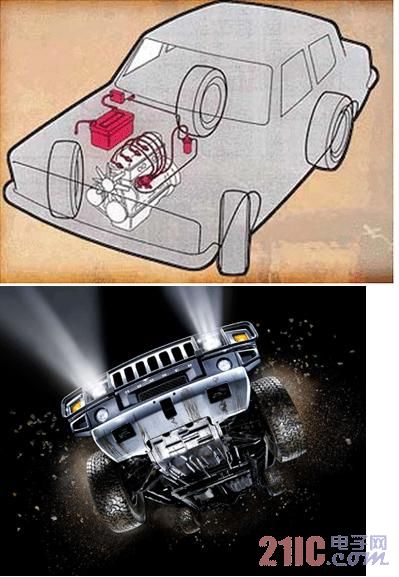First, the characteristics of the battery ignition system This article refers to the address: http:// The battery ignition system is composed of an ignition coil, a spark plug, a breaker, a distributor, an ignition switch, a high-voltage wire, etc., and belongs to an ignition system of an inductive energy storage type. The ignition characteristics of the battery ignition system can be summarized as follows: (1) The ignition energy stored in the ignition coil is proportional to the square of the primary current. In the case where the primary current is constant, the larger the primary inductance, the more ignition energy is stored. (2) Due to the existence of the primary inductance, the primary current is determined to vary exponentially. That is to say, when the contact is closed, the primary current does not immediately increase to a certain value due to the back EMF, but gradually increases from zero. When the closing time is infinitely long, the primary current reaches a certain extreme value. The closing time depends on the speed of the engine and the closing angle of the contacts. In the case where the contact closure angle is constant, the closing time is inversely proportional to the engine speed. It is not difficult to see that the higher the engine speed, the smaller the primary current and the smaller the ignition energy. This is a prominent feature of the battery ignition system and an insurmountable disadvantage. (3) It is precisely because of the existence of the inductor that the ignition coil not only induces the secondary back EMF at the moment when the contact is disconnected, but also induces the primary back EMF, causing sparks between the contacts, ablating the contacts. . (4) The occurrence of back EMF not only causes sparks between the contacts, but also reduces the rate at which the primary current is cut off, causing the rate of rise of the secondary potential to decrease. The reason why the battery ignition system is sensitive to spark plug carbon deposits is here. In response to this outstanding feature of the battery ignition system, people take corresponding countermeasures, including thinking about the structure of the breaker. Second, the structural characteristics of the breaker The breaker is mainly composed of a cam, a contact pair, an ignition advance device and the like. The cam of the breaker repeatedly controls the closing of the contacts and turns on the primary current during the rotation. The capacitor and the contacts are connected in parallel, and the task is to form a loop for the primary induced back EMF, which reduces the ablation of the contacts and speeds up the on/off rate of the primary current. The final action of the centrifugal ignition advancement device and the vacuum ignition advancement device is also reflected on the contact pair, so that the ignition advance angle varies with engine speed and load to obtain an optimum ignition advance angle. Ignition conditions are not only affected by the contact, but also closely related to the technical state of the ignition advance, capacitors and cams. Therefore, when people analyze the ignition system conditions, they should be connected to these related electrical appliances and components. For example, when the edge of the cam is severely worn, it will affect the opening and closing time of the contact; when the capacitor leaks, the contact will quickly ablate. Third, the use of contact technology analysis In terms of contact pairs, the technical conditions mainly include: the size of the gap, the size of the contact surface, the degree of ablation of the contact surface, and the tension of the spring. (1) The direct factor affecting the spring tension is the thermal effect of the primary current. When the generator voltage is high, the primary current is too large, and the engine low-speed working time is too long, when the additional resistance is short-circuited or the secondary coil of the ignition coil is short-circuited, the spring will be annealed due to the enhancement of the thermal effect, and the tension is weakened. (2) Although the spark between the contacts is protected by the capacitor, it cannot be completely eliminated, so the ablation of the contact by the spark is naturally unavoidable. There are many factors involved in contact ablation; 1 generator regulation voltage is high, primary current is too large; 2 ignition coil and capacitor capacity are not properly matched; 3 contact surface is dirty or contact surface is small; 4 capacitor is faulty or contact Poor; 5 contact gap is too large or too small; 6 primary coil or additional resistance short circuit; 7 engine low speed running time is too long. (3) The size of the contact gap affects both the closing angle, the primary current and the secondary voltage, as well as the ignition timing. Therefore, when adjusting the ignition timing, the gap of the contacts must first be adjusted. The standard value of the contact gap is generally 0.35 mm - 0.45 mm. In use, the contact gap changes due to ablation or wear, resulting in changes in ignition voltage and ignition time. (4) The contact surface of the contact affects the contact resistance, the primary current and the secondary voltage, so ensuring that the two contact faces of the contact are parallel is an important part of the contact maintenance. In short, for the ignition system of the battery, the breaker is both a key component and the weakest link. Therefore, the daily maintenance of the contacts is crucial. Kitchen Exhaust Hood,Gas Hob 4 Burner,Stainless Steel Gas Hob,4 Burner Gas Cooker Hob Xunda Science & Technology Group Co.ltd , https://www.xundatec.com